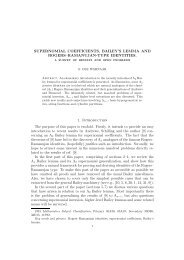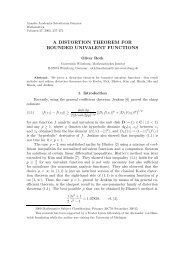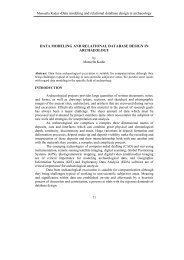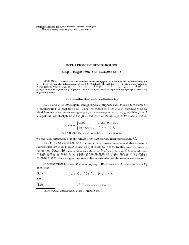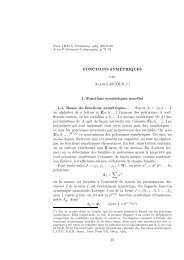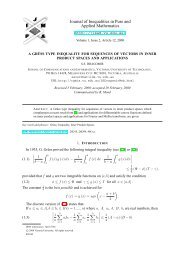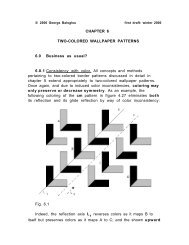THE COMBINATORICS OF THE AL-SALAM-CHIHARA q ...
THE COMBINATORICS OF THE AL-SALAM-CHIHARA q ...
THE COMBINATORICS OF THE AL-SALAM-CHIHARA q ...
You also want an ePaper? Increase the reach of your titles
YUMPU automatically turns print PDFs into web optimized ePapers that Google loves.
2 DONGSU KIM, DENNIS STANTON, AND JIANG ZENGAnshelevich [2] has recently considered a q-analogue of the three-term recurrence (1.2)for Cn(x a + a, a) and proved that the linearization coefficients of the corresponding polynomialsare polynomials of a and q with positive integer coefficients (see Theorem 6).The aim of this paper is to study the combinatorial aspects of a new q-analogue ofCharlier polynomials, which is a re-scaled version of Anshelevich’s q-polynomials and turnsout to be a special re-scaled version of the Al-Salam-Chihara polynomials. We shall givea combinatorial proof of Anshelevich’s result by using the combinatorial interpretationsof the polynomials and their moments. It is inspired by the beautiful proofs for otherclassical orthogonal polynomials in [7, 10].This paper is organized as follows: in the next two sections we give the definitionsand combinatorial interpretations of the new q-Charlier polynomials and their moments,Corollary 3 and Theorem 4. The explicit linearization coefficients are given in §4 inCorollary 8. We then give the killing involution in §5. We present a variation Ĉn(x|q)of the polynomials C n (x, a; q) in §6, which has the advantage to include the q-Hermitepolynomials in [10] as a special case.We collect here some well-known facts about Charlier polynomials.The generating function is∞∑Cn(x) a tnn! = e−at (1 + at) x . (1.3)n=0The moment sequence µ n is given by the following formula:∞∑µ n = L(x n ) = x n −a axn∑ex! = S(n, k)a k , (1.4)x=0where S(n, k) denotes the Stirling number of the second kind. The orthogonality reads:∞∑L(Cm(x)C a n(x)) a = Cm(k)C a n(k) a e−a a k= n!a n δ mn .k!The linearization coefficient c n 3n 1 n 2k=0is defined by:k=1C a n 1(x)C a n 2(x) = ∑ n 3c n 3n 1 n 2C a n 3(x).By orthogonality we have c n 3n 1 n 2= L(Cn a 1(x)Cn a 2(x)Cn a 3(x))/L(Cn a 3(x)Cn a 3(x)).For Charlier polynomials it is easy to derive from (1.3) and (1.4) that∞∑L(Cn a 1(x) . . . Cn a k(x)) tn 11n 1 ! . . . tn kkn k ! = ea(e 2(t 1 ,...,t k )+...+e k (t 1 ,...,t k )) ,n 1 ,...,n k =0where e i is the elementary symmetric function of degree i. It follows thatL(C a n 1(x)C a n 2(x)C a n 3(x)) = ∑ ln 1 !n 2 !n 3 !a l+n 3l!(n 3 − n 1 + l)!(n 3 − n 2 + l)!(n 1 + n 2 − n 3 − 2l)! . (1.5)


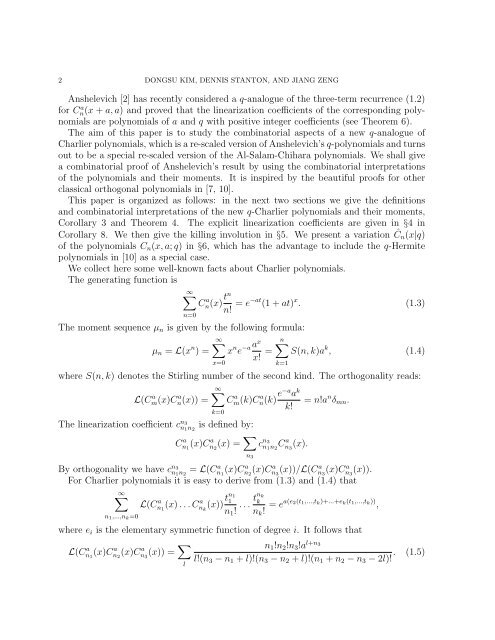
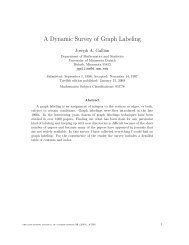

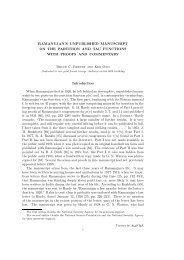
![(.,t ] and [s, .) , where [s,t ] = {s' GT; s ¤ s' ¤ t} , (.,t ] = {s' GT; s' ¤ t} and ...](https://img.yumpu.com/43303393/1/184x260/t-and-s-where-st-s-gt-s-a-s-a-t-t-s-gt-s-a-t-and-.jpg?quality=85)
